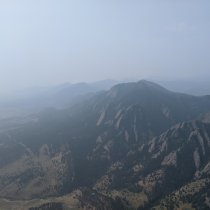NEON data quantifies topographic change caused by 2013 Boulder flood
March 11, 2015
In September 2013, Boulder, CO experienced a seven day storm event which resulted in an accumulated rainfall greater than the yearly average: the unprecedented rainfall caused severe flooding and devastation across the northern Front Range of Colorado.
Prior to the storm event, on June 26-27, 2013, the National Ecological Observatory Network (NEON) conducted an airborne remote sensing survey of Boulder as part of yearly test flights. Shortly after the flood subsided, on October 8, 2013, NEON conducted a second airborne flight of the same area. Given the timing of the flights, the pre-flood and post-flood surveys present a distinct dataset that may be used to evaluate topographic change driven by a severe storm event.
Surveys were conducted with the NEON Airborne Observation Platform (AOP), which contains a Light Detection and Ranging (LiDAR) sensor, high-resolution digital camera and an imaging spectrometer mounted in a Twin otter aircraft. The LiDAR sensor provides detailed information about topography and vegetation, critical for assessing changes in landscape. To learn more about LiDAR, check out NEON’s LiDAR-related science videos.
NEON produced pre-flood and post-flood high resolution digital topographic maps, or Digital Terrain Models (DTMs), of the ground surface using information collected from the LiDAR sensor. NEON compared the pre-flood and post-flood maps to quantify changes in elevation and vegetation.
Since this unique dataset provides information about how the storm event impacted a specific area, mapping topographic and vegetative changes may inform local mitigation planning and disaster risk reduction efforts. However, topographic change over time and across the continent is more difficult to interpret. Using standardized collection methods over a projected timespan of 30 years, in combination with other ground data, NEON airborne data will measure changes in our landscape and improve our understanding and forecasting of ecological change.
For more information on LiDAR data acquisition parameters, data processing methods and determination of topographic change of the Boulder flood, please review TM-006: NEON AOP Surveys of City of Boulder Pre and Post 2013 Flood Event. The pre-flood and post-flood data airborne data are available through the NEON website upon request.
Update: Use this data in your classroom to teach about ecological disturbances! Teaching Module: Quantifying The Drivers and Impacts of Natural Disturbance Events – The 2013 Colorado Floods

